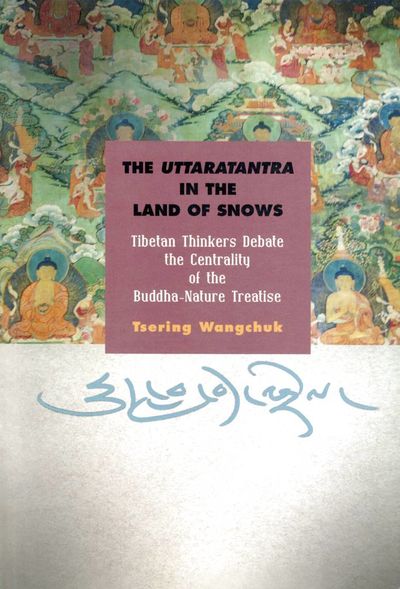The Uttaratantra in the Land of Snows
< Books
| Line 7: | Line 7: | ||
}} | }} | ||
|FullTextRead=No | |FullTextRead=No | ||
| − | |BookEssay=Tsering Wangchuk's The Uttaratantra in the Land of Snows is a clear and concise introduction to the history of the Uttaratantra and buddha-nature theory in pre-modern Tibet. It is an ideal introduction for anyone not yet familiar with the buddha-nature debate in Tibet. Wangchuk summarizes the writings and views of several of the most important Tibetan philosophers who weighed in on buddha-nature between the eleventh and fifteenth centuries from Ngok Lotsāwa through Sakya Paṇḍita to Dolpopa and Gyaltsap Je. | + | |BookEssay=Tsering Wangchuk's ''The Uttaratantra in the Land of Snows'' is a clear and concise introduction to the history of the Uttaratantra and buddha-nature theory in pre-modern Tibet. It is an ideal introduction for anyone not yet familiar with the buddha-nature debate in Tibet. Wangchuk summarizes the writings and views of several of the most important Tibetan philosophers who weighed in on buddha-nature between the eleventh and fifteenth centuries from Ngok Lotsāwa through Sakya Paṇḍita to Dolpopa and Gyaltsap Je. |
| − | The book is divided into three main sections: early Kadam thinkers who attempted to fold the Uttaratantra's positive-language teaching on buddha-nature into mainstream Madhyamaka doctrine of non-affirming negation. They did so by asserting that buddha-nature was in fact a synonym of emptiness, and was therefore a definitive teaching. The second stage was reactions during the thirteenth century. Sakya Paṇḍita, for example, rejected the conflation of buddha-nature and emptiness and declared the teaching to be provisional; early Kagyu thinkers revived the positive-language teachings and asserted that such statements were definitive, and Dolpopa taught "other-emptiness," the strongest expression of positive-language doctrine ever advocated in Tibet. Finally, in the fourteenth century, a number of mainly Geluk thinkers such as Gyaltsap Je reacted against Dolpopa and all synthesis of Yogacāra and Madhyamaka thought, relegating the Uttaratantra again to provisional status. | + | The book is divided into three main sections: early Kadam thinkers who attempted to fold the Uttaratantra's positive-language teaching on buddha-nature into mainstream Madhyamaka doctrine of non-affirming negation. They did so by asserting that buddha-nature was, in fact, a synonym of emptiness, and was, therefore, a definitive teaching. The second stage was reactions during the thirteenth century. Sakya Paṇḍita, for example, rejected the conflation of buddha-nature and emptiness and declared the teaching to be provisional; early Kagyu thinkers revived the positive-language teachings and asserted that such statements were definitive, and Dolpopa taught "other-emptiness," the strongest expression of positive-language doctrine ever advocated in Tibet. Finally, in the fourteenth century, a number of mainly Geluk thinkers, such as Gyaltsap Je, reacted against Dolpopa and all synthesis of Yogacāra and Madhyamaka thought, relegating the Uttaratantra again to provisional status. |
The advantage of Wangchuk's historical frame is that all assertions are placed in the easy context of an opponent or supporter's writing, thus reminding the reader that buddha-nature theory in Tibet is an ongoing conversation, a debate between the two fundamental doctrinal poles of positive and negative descriptions of the ultimate. | The advantage of Wangchuk's historical frame is that all assertions are placed in the easy context of an opponent or supporter's writing, thus reminding the reader that buddha-nature theory in Tibet is an ongoing conversation, a debate between the two fundamental doctrinal poles of positive and negative descriptions of the ultimate. | ||
| Line 74: | Line 74: | ||
|QuotesTabContent={{GetBookQuotes}} | |QuotesTabContent={{GetBookQuotes}} | ||
|PublisherLogo=File:SUNY Press logo.jpg | |PublisherLogo=File:SUNY Press logo.jpg | ||
| − | |PostStatus=Needs | + | |PostStatus=Needs Final Review |
}} | }} | ||
Revision as of 16:15, 6 August 2018
With its emphasis on the concept of buddha-nature, or the ultimate nature of mind, the Uttaratantra is a classical Buddhist treatise that lays out an early map of the Mahāyāna path to enlightenment. Tsering Wangchuk unravels the history of this important Indic text in Tibet by examining numerous Tibetan commentaries and other exegetical texts on the treatise that emerged between the eleventh and fifteenth centuries. These commentaries explored such questions as: Is the buddha-nature teaching found in the Uttaratantra literally true, or does it have to be interpreted differently to understand its ultimate meaning? Does it explicate ultimate truth that is inherently enlightened or ultimate truth that is empty only of independent existence? Does the treatise teach ultimate nature of mind according to the Cittamātra or the Madhyamaka School of Mahāyāna? By focusing on the diverse interpretations that different textual communities employed to make sense of the Uttaratantra, Wangchuk provides a necessary historical context for the development of the text in Tibet. (Source: SUNY Press)
| Citation | Wangchuk, Tsering. The Uttaratantra in the Land of Snows: Tibetan Thinkers Debate the Centrality of the Buddha-Nature Treatise. Albany: State University of New York Press, 2017. |
|---|---|


